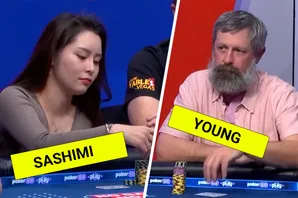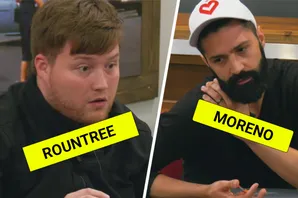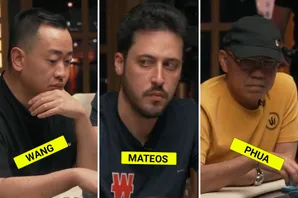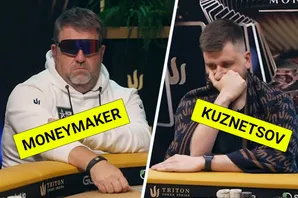'Improve Your Poker Now!' by Topher Goggin and Alexander Fitzgerald is available as an ebook or paperback from D&B Poker.
My new book with noted author and coach Alex Fitzgerald, Improve Your Poker Now! — A Guide for Serious Amateurs, has one goal: to give recreational players the tools they need to improve, and do it with straightforward advice that everyday people can execute at the tables.
While the book delves into a comprehensive series of strategic tenets, today we’ll dive deeper into an often-overlooked topic in poker teaching: paying attention at the table.
I don’t have to tell you about the importance of focus. Opponents give away information like a dog shedding hair on a couch. Betting patterns, timing tells, you name it. Yet poker rooms are filled with people on their phones, watching the game, listening to podcasts – basically doing everything but watching the action.
Could you envision this in any other competitive endeavor? Imagine Magnus Carlsen sitting down for a championship chess match while trying to watch an episode of Gilmore Girls. Or an NFL coach pulling out his phone to send a few emails and check TikTok during the second quarter. It’s inconceivable. Yet poker players do this every day.
Why do we struggle to focus at the poker table?
If focus is so important, why do so many recreational players seem to treat it like an afterthought?
Simple. Consistently paying attention is harder than it looks. With so many things to observe, the task can overwhelm all but the most seasoned pros. We live in a world of distraction. Countless stimuli compete for our attention. And when the going gets tough, the screens usually win the battle.
We all know focusing is a challenge. I struggle with this as much as anyone. The question is: how do we overcome these obstacles and become more attentive at the tables?
Observation dies without a plan
Even the most serious effort to observe poker action can get derailed before it starts. It’s not enough to tell yourself, “Today I’m going to pay attention.” The secret lies in the logical follow-up. “To what?”
If a player arrives at the table without a plan, they will soon find themselves trying to watch and remember everything. Who opened that last hand? How many people flatted? From what positions? How big did he bet on the flop? Wait, did he lead that turn out of position? Was that with a gutter? Was the other player in the cutoff or the hijack? When she checked back before, did she have a blocker? No, wait, that was the other hand...
After a couple of orbits, everything starts to jumble together. The process becomes overwhelming. Folks give up and revert to their standard game. The next thing you know, they’re back on their phone.
Poker training routinely fails players in this area. Sure, almost every writer and coach tells their students to pay attention. But very few help those students learn how to pay attention.
Focusing is a skill
The first step to paying closer attention is accepting that observation is a skill – a skill you will have to train. And that means starting simple.
Suppose you were tasked with teaching a teenager to drive. You would not start by ushering the kid into a 747 and telling him to take it for a quick flight. Yet that’s exactly what recs try to do when they try to watch everything at once.
Young drivers must progress incrementally. They’ll learn the controls on a golf cart, go kart, or even the bumper cars at the county fair. Then they can progress to a car on a backroad with fewer things to observe. Only once they master the backroad will they try a bigger street, and finally the highway.
You need to follow a similar progression to progress to the skills of a Negreanu or Hellmuth.
Here’s what Alex and I recommend. Start with one thing. The next time you play, pick one specific aspect of the game and pay attention to that and that alone. But really, consciously pay attention. By the end of the session, you should be able to provide a thorough description of what you’ve learned about that topic.
What should you observe?
So what should you pick to watch? Anything will work, but the best ideas are ones where the information you learn will directly help you make better decisions. Here are a few suggestions:
- How do your opponents play from the big blind? Players who frequently fold are ripe for attack. Players that always call have wide ranges you can exploit post-flop.
- How does your table respond to c-bets? Who usually folds? Who always calls? Adjust your c-betting strategy accordingly.
- Does anyone three-bet frequently? You should be more cautious about opening marginal hands if a prolific raiser is lurking on your left.
- Who looks at their cards before it’s their turn? Do they give away when they are folding? Knowing what your opponents are planning to do will open up a host of preflop options.
- Look for loose openers. This is our personal favorite, and what Alex and I recommend in our book. Watch how frequently your opponents raise preflop, and pay specific attention to the hands they eventually show down. Take note when you see someone open with something like J7s or A4o from early position. That’s your cue that they are likely playing junk everywhere. This is the person you want to attack.
Weak players with trashy ranges are begging you to exploit them. If you mostly face recreational competition, you can supercharge your results by going after loose openers. That’s particularly true of ones that also struggle to fold mediocre hands postflop.
We can’t exploit these players until we identify them. That’s why focusing on opening hands is so powerful. Frequent openers’ wide ranges are ideal to three-bet and isolate when you’re in position. You can also aggressively defend against them from the big blind, including looking for profitable check-raises when they habitually c-bet. Not only will you routinely pick up pots when they miss, but their weak holdings will make scads of second-best hands, allowing you to bleed them for value when you flop well.
Taking it further
By picking one thing to watch, you give yourself a manageable starting goal. Keeping things simple increases your likelihood of staying focused and will prevent you from becoming overwhelmed and giving up. And by choosing a useful target that allows you to exploit your opponents, your results will improve as well.
Once you master observing one aspect of the game, it’s time to add another. And then another. Before long, the process will become second nature, no longer requiring your conscious effort. Just like an experienced driver automatically observes droves of details while driving, you’ll be able to take in piles of poker data without feeling like it requires extra effort. You just have to build the foundation first.
Focusing at the poker table: the wrap-up
Poker players’ openness to distraction at the table can be mind-boggling. With hundreds or thousands of dollars on the line, seeing players fire up a movie or devote their brainpower to Wordle is shocking.
But it also presents a golden opportunity. Distracted players are wasting chance after chance to gain info that could earn them easy chips. The chips the distracted players loses, the observant player picks up. You can be that player.
Improve Your Poker Now! goes into much deeper detail about ways to use information from the table to your benefit. The key for now is to recognize that your focus doesn’t have to go from zero to Phil Ivey in one session. Start small. Practice. Expand from there. Then enjoy the extra wins.
'Improve Your Poker Now!' by Topher Goggin and Alexander Fitzgerald is available as an ebook or paperback from D&B Poker.






























